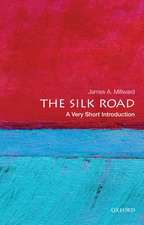An Historical Geography of Peiping: China Academic Library
Autor Renzhi Houen Limba Engleză Hardback – 29 iul 2014
Din seria China Academic Library
- 20%
 Preț: 580.27 lei
Preț: 580.27 lei -
 Preț: 387.58 lei
Preț: 387.58 lei -
 Preț: 392.97 lei
Preț: 392.97 lei - 15%
 Preț: 648.24 lei
Preț: 648.24 lei -
 Preț: 388.90 lei
Preț: 388.90 lei -
 Preț: 393.35 lei
Preț: 393.35 lei -
 Preț: 387.38 lei
Preț: 387.38 lei - 15%
 Preț: 586.05 lei
Preț: 586.05 lei -
 Preț: 382.18 lei
Preț: 382.18 lei - 15%
 Preț: 643.84 lei
Preț: 643.84 lei -
 Preț: 396.24 lei
Preț: 396.24 lei -
 Preț: 394.87 lei
Preț: 394.87 lei -
 Preț: 398.15 lei
Preț: 398.15 lei - 18%
 Preț: 739.62 lei
Preț: 739.62 lei - 20%
 Preț: 565.09 lei
Preț: 565.09 lei - 18%
 Preț: 729.36 lei
Preț: 729.36 lei - 15%
 Preț: 650.04 lei
Preț: 650.04 lei - 15%
 Preț: 585.08 lei
Preț: 585.08 lei -
 Preț: 386.22 lei
Preț: 386.22 lei - 20%
 Preț: 587.03 lei
Preț: 587.03 lei - 15%
 Preț: 638.89 lei
Preț: 638.89 lei -
 Preț: 389.70 lei
Preț: 389.70 lei -
 Preț: 389.88 lei
Preț: 389.88 lei -
 Preț: 384.09 lei
Preț: 384.09 lei - 15%
 Preț: 643.16 lei
Preț: 643.16 lei - 18%
 Preț: 906.48 lei
Preț: 906.48 lei -
 Preț: 394.51 lei
Preț: 394.51 lei - 15%
 Preț: 654.43 lei
Preț: 654.43 lei - 15%
 Preț: 643.99 lei
Preț: 643.99 lei -
 Preț: 388.72 lei
Preț: 388.72 lei -
 Preț: 392.21 lei
Preț: 392.21 lei -
 Preț: 394.87 lei
Preț: 394.87 lei
Preț: 389.88 lei
Nou
Puncte Express: 585
Preț estimativ în valută:
74.61€ • 79.78$ • 62.20£
74.61€ • 79.78$ • 62.20£
Carte tipărită la comandă
Livrare economică 17 aprilie-01 mai
Preluare comenzi: 021 569.72.76
Specificații
ISBN-13: 9783642553202
ISBN-10: 3642553206
Pagini: 200
Ilustrații: XXXI, 165 p. 60 illus., 55 illus. in color.
Dimensiuni: 155 x 235 x 17 mm
Greutate: 0.46 kg
Ediția:2014
Editura: Springer Berlin, Heidelberg
Colecția Springer
Seria China Academic Library
Locul publicării:Berlin, Heidelberg, Germany
ISBN-10: 3642553206
Pagini: 200
Ilustrații: XXXI, 165 p. 60 illus., 55 illus. in color.
Dimensiuni: 155 x 235 x 17 mm
Greutate: 0.46 kg
Ediția:2014
Editura: Springer Berlin, Heidelberg
Colecția Springer
Seria China Academic Library
Locul publicării:Berlin, Heidelberg, Germany
Public țintă
ResearchCuprins
Chi under the Chou Dynasty (ca.1122—220 B.C.): Capital of the Feudal State of Yen.- Chi During the Ch’in-Han Period (221 B.C.—A.D.220): A Phase of Commercial Expansion.- Chi in the Dark Ages prior to the Unification of Sui (221—589): With Special Reference to the Development of Local Irrigation.- Yu Chou of Sui and T’ang Dynasties up to the Khitan Occupation (590—937): Key Position in Frontier Struggle.- Nan-ching (938—1122) of the Liao Dynasty (916—1125).- Chung-tu (1151—1215) of the Chin Dynasty (1115—1234).- Khanbaliq (1267—1368) of the Yüan Dynasty (1260—1368).- Peking (1420—1911) of the Ming and Ch’ing Dynasties (1368—1911).
Textul de pe ultima copertă
This book is about the city of Peiping in China, also known as Beijing and Peking, and a city of great historical significance. Divided into three parts, this work explores Peiping first as a frontier city at a time when the Great Wall was established, from the Chou dynasty (ca.1122—220 B.C.) until the T’ang Dynasties up to the Khitan Occupation (A.D. 590—937). The second part explores Peiping as it becomes a national centre, through the Liao Dynasty and the Chin Dynasty, until 1234, and the third part explores how it became the capital of the Chinese empire, until 1911. This work is a historical geography and the introduction details topographical features and geographical relations of the city, describing the way in which the mountains rise from the plain creating concave arms to enclose Peiping, leading to the name, the ‘Bay of Peiping’. We learn that the mountains frequently reach over 3000ft and have practically no foot-hills, whilst the bay itself is filled with sediments of gravel, sand, loam and loess which have been deposited in horizontal strata, to a great depth. Numerous illustrations and figures are included, and readers will see how the city sits between two rivers, the Hun (浑河 or Muddy River) and the Pai (白河 or White River). These chapters reveal how each river has made its contribution to the material development of the city and its environs, including through irrigation and as the Hun River shifted its course. Owing to the geography of the region, almost all roads leading from the northern lands of Mongolia and Manchuria to the great plain of North China in the south are bound to converge at Peiping. The historical consequences of this, as well as local climate conditions and other aspects of geography are explored in this book, which traces the historical rise to eminence of Peiping.
Caracteristici
Traces the historical rise to eminence of Peiping from ca. 1122 B.C. until A.D. 1911 Details topographical features and geographical relations of the city of Peiping, a natural focus of long distance land communications Reveals the historical role of rivers and mountain passes in China, including the famous Shan-hai Kwan guarding the eastern end of the Great Wall Includes supplementary material: sn.pub/extras













